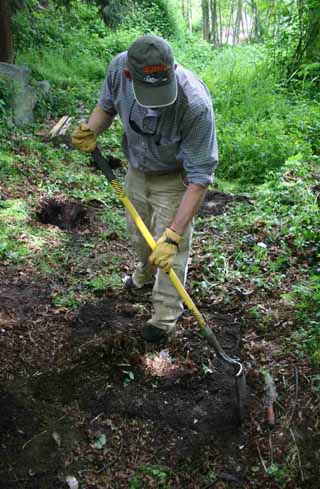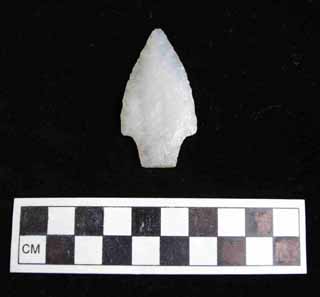
Surveys
DJC.COM
November 10, 2005
Add an archaeologist to the design team
Jones & Stokes

A Jones & Stokes archaeologist digs into the soil as part of a recent cultural resources survey in King County.
|
When a spearhead was recently found in a Kent backyard it proved once again that what is old is news. More than just an interesting artifact from the past, the 2,500-year-old piece delayed construction of 120 single-family homes on an adjacent site.
When the spearhead was found, the discovery yielded mild interest from the landowners. Further investigation led to a request by King County to check the development site for similar artifacts. The subsequent cultural resources investigations failed to identify any significant artifacts, allowing construction of the development to continue.
This incident points out how archaeology and architectural history are playing an increasingly important role in planning the future in Puget Sound area as we experience increasing levels of development.
"The discovery of the spearhead highlights how important an understanding of cultural resources is for the successful completion of projects today," said Amy Rucker, business development leader for the Pacific Northwest Region of Jones & Stokes, the firm that conducted the cultural resources assessment in Kent.
Rucker said it doesn't matter whether the development is in the form of housing, a commercial site, or a new road or transmission line. "Our specialists are working on more and more projects throughout the Pacific Northwest that involve a need to determine the impacts of development on resources from the past," Rucker said.
One case in point is a graving dock project in Port Angeles. Significant cultural resources, including American Indian remains, were unearthed during the construction of a large facility planned for building and floating sections of the new Hood Canal Bridge. According to its Web site, the Washington Department of Transportation's original timeline — which called for a 2006 completion date — has been pushed back to at least 2009 as a result of ongoing discoveries at what is known as the Tse-whit-zen site.
"The graving dock project was an eye-opener for the entire region as to the importance and sensitivity of cultural resources," Rucker said.

Discovery of this 2,500-year-old arrowhead in a Kent backyard delayed construction of a nearby residential project.
|
Cultural resources 101
Cultural resources refer not only to Native American artifacts but also to a much broader range of items and issues, including prehistoric and historic archaeological sites, traditional cultural places and historic buildings. Properties of historic significance, for example, can include houses, buildings and military installations such as the Puget Sound Naval Shipyard in Bremerton and the former Sand Point Naval Air Station in Seattle. Such historic properties are often studied and surveyed by a subset of cultural resources experts specializing in architectural history.
Several laws and regulations require project managers to identify and evaluate historical and archaeological resources that could be affected by construction. This requires a full understanding of these regulations and knowledge of regional issues and historical themes in the Pacific Northwest.
Historic properties and artifacts are inventoried under federal and state historic preservation guidelines in order to assure that they are properly catalogued and the region's history is recorded.
"The regulations are in place to protect the cultural resources as the legacy we want to preserve and pass on to future generations," Rucker said. "Our job as experts is to find out what's out there, and assess how historically significant it is."
One of the challenges arising in conducting historical resource inventories is the increasing number of properties that are reaching the 50-year mark — a magic number for potential eligibility as significant resources under the National Historic Preservation Act (NHPA). Although many will ultimately not be considered significant — most suburban houses from the 1950s, for example — the challenge remains (and the law requires) that these resources be efficiently and cost-effectively inventoried to identify those that truly are significant.
Amendments to the NHPA in 1999 heightened the importance of identifying and evaluating properties of significance to American Indians. Additional emphasis has been placed on the need to consult with tribes early in the process to determine the significance of historic properties and artifacts.
Cultural resources assessment and planning also includes the integration of the National Environmental Policy Act with other regulations, including the NHPA. Careful coordination of surveying for significant cultural resources and determining the impact of a proposed project on those resources is necessary to meet regulatory requirements while preserving history.
On the road to history
As another example of the 50-year-old rule, the Federal Highway Administration will identify elements that have national or exceptional historic significance over the entire 40,000-plus miles of the interstate highway system.
"It is easy to take for granted the interstate highway system and roads around us," said Richard Starzak, a Jones & Stokes principal and the head of the firm's Interstate Highway project. "From its initial concept as a way to create jobs for Americans during the Depression to the creation of the modern highway system under the Federal-Aid Highway Act of 1956, highways have played a significant historic role to the nation as a whole as well as to the Pacific Northwest in particular. Our job is to identify those properties that deserve some kind of protection or attention. It's really helping preserve a crucial part of our heritage as Americans."
Jones & Stokes cultural resources staff, including experts from the firm's offices throughout the West, will represent the Federal Highway Administration and work with various state historic preservation offices and departments of transportation to identify elements of the interstate highway system that have national or exceptional importance. They will be screening and evaluating everything in the interstate system, including highways, bridges, overpasses, rest stops, tollbooths, vista lookouts and junctions. Jones & Stokes will be the team leader in all 50 states, and the principal investigator in 18 states.
Jones & Stokes recently surveyed sections of historic Pacific Highway in Pierce County for two separate corridor improvement projects. An archaeologist and architectural historian were sent to the project areas to evaluate significant historic properties that might be affected as a result of the project. In both projects, historic properties were identified as potentially being affected by the proposed construction, but none was determined to be eligible for listing in the National Register of Historic Places.
Preserving the past to build the future
In the future, it is possible that other properties may be recognized for inclusion in the National Register of Historic Places. But even those that don't reach that highest level of protection may be preserved and protected by local groups. As the region continues to grow and new development and infrastructure are built, significant old buildings, roads and archaeological resources will not just become history, but will be preserved as history.
Cultural resources play a key role in determining the significance of the region's past as well as recording and preserving the region's history while paving the way for advancements in the Pacific Northwest.
Jason B. Cooper, M.A., is an archaeologist with experience managing cultural resource inventories, surveys and data recoveries throughout the western United States. He is a member of the Register of Professional Archaeologists and an active participant in the Association for Washington Archaeology.
Other Stories:
- How to get more floor space in high-rise condos
- Listen closely on how to find leaky pipes
- Fitting feng shui into Western architecture
- Designing a feast for the eyes
- Design dialogues cultivate Seattle's Chinese garden
- Artists, architects find a sense of place
- Can the Northwest be energy independent again?
- Is Seattle ready to slim down its residential towers?
- New waterfront mandate: OK isn't good enough
- A modern way to fortify an old building
- Are you ready for a $30B quake?
- Try integrated 3-D design for better buildings
Copyright ©2009 Seattle Daily Journal and DJC.COM.
Comments? Questions? Contact us.